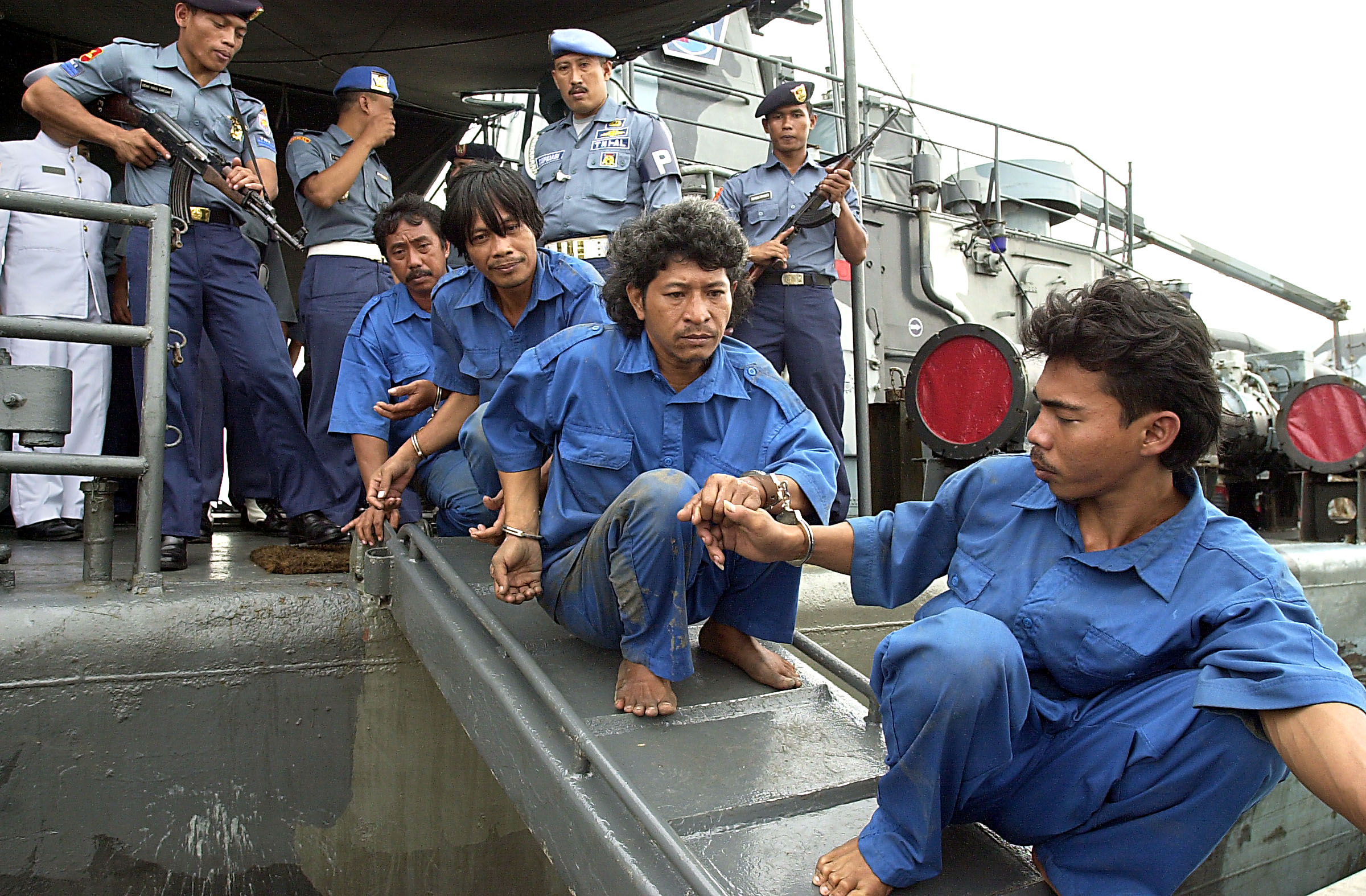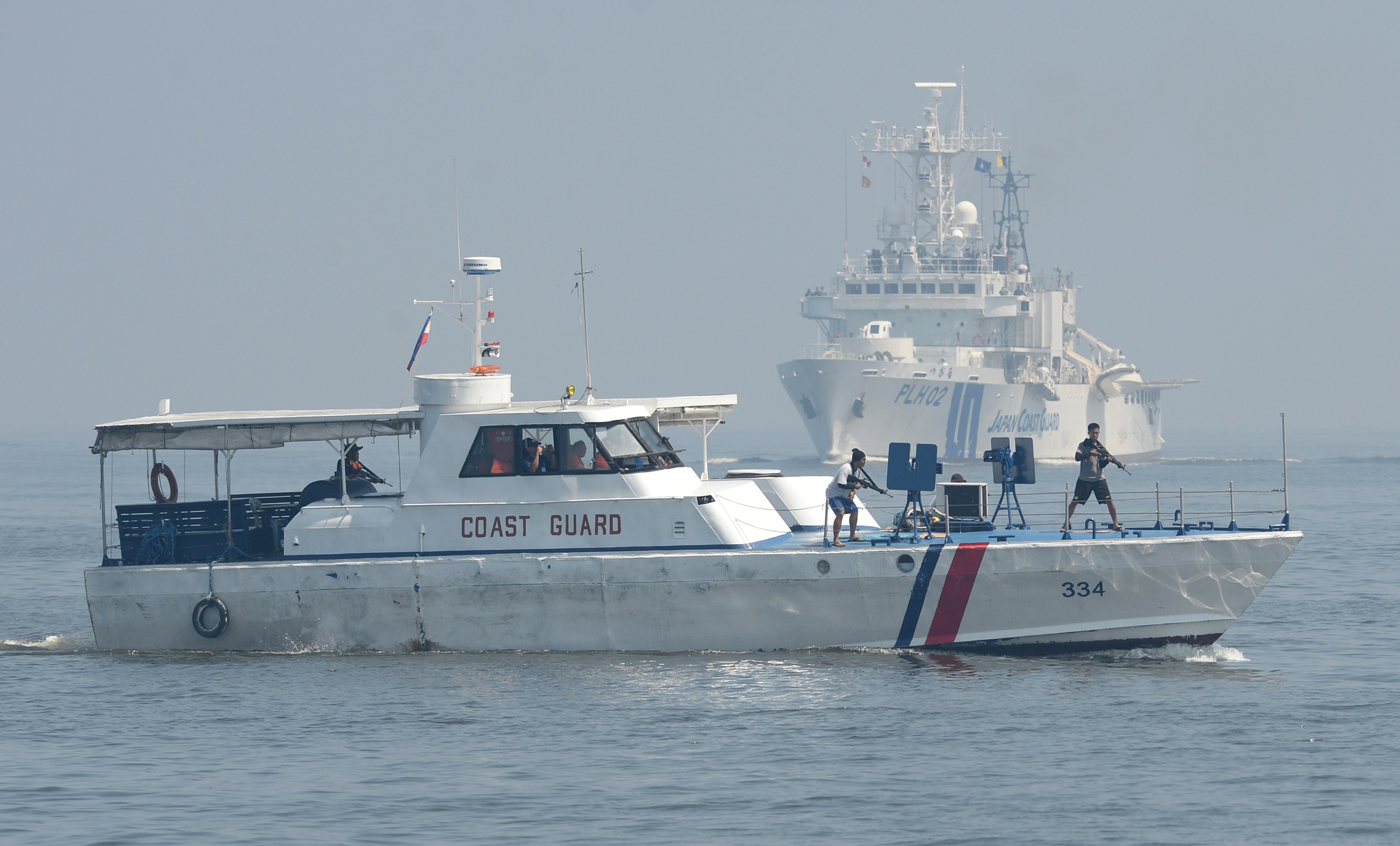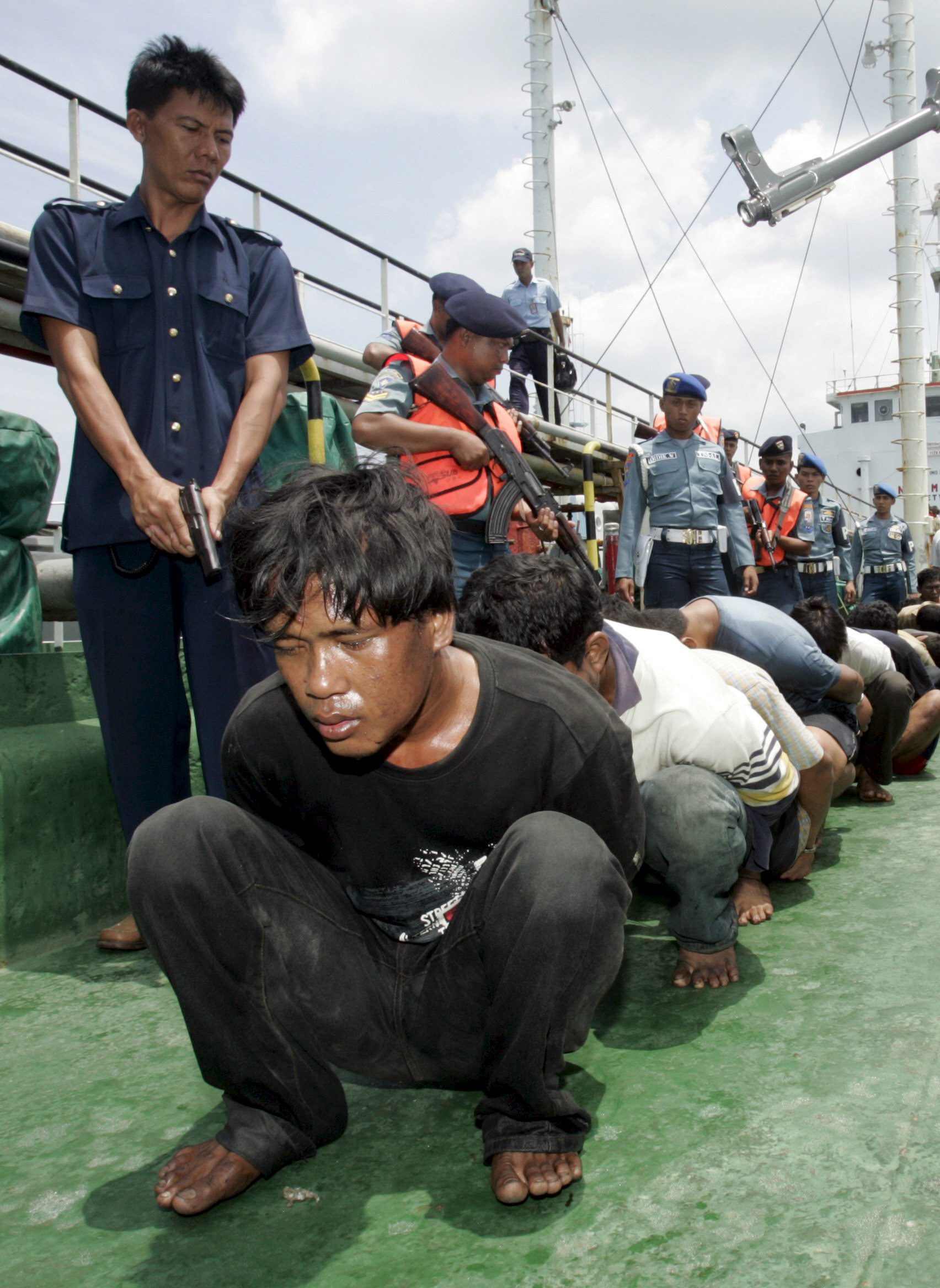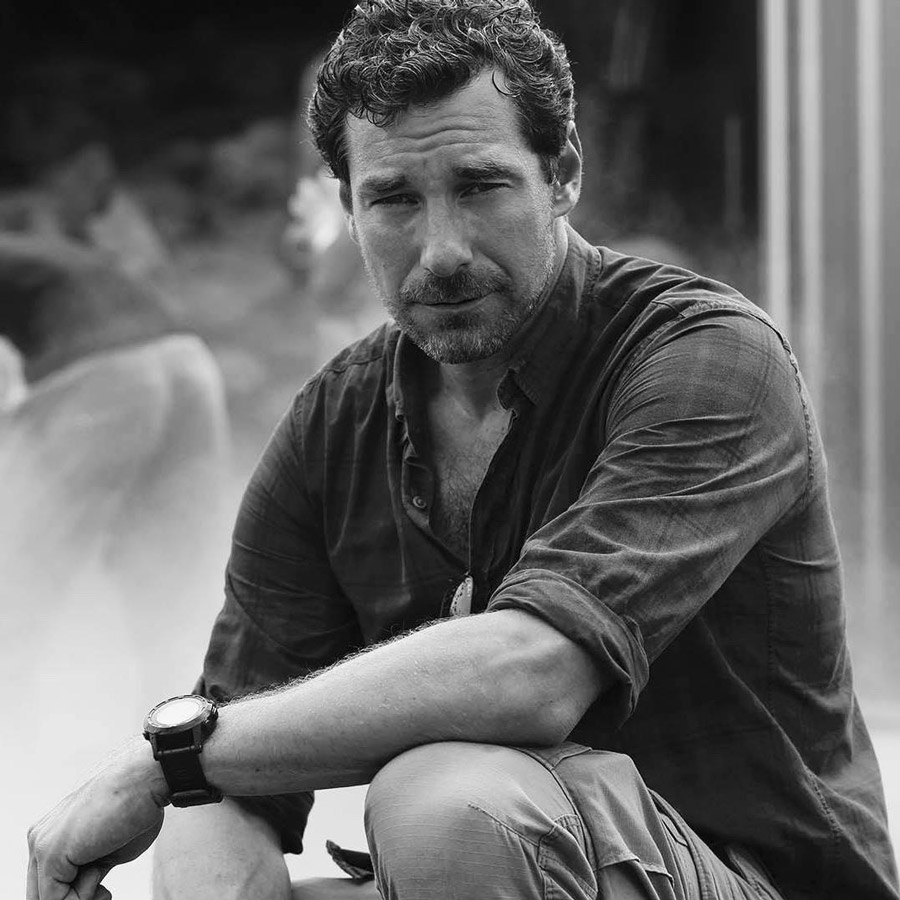This article is part one in our deep-dive into Southeast Asia’s modern-day pirate problem. You can read the second part here. Feature photo: Eric Pasquier
On a crowded ferry travelling through Indonesian waters, an unlikely duo – one an investigator, the other a criminal – meet for an interview. As other passengers push past, the two men greet each other, making small talk as the ferry sputters to life and motors away from the pier.
A television is propped above the bobbing heads of the passengers, and a series of DVDs – each illegally pirated – are queued up as entertainment for the ride. The first film to play is Captain Phillips, the dramatisation of the 2009 Maersk Alabama pirate hijacking in the Indian Ocean. Faces of Somali pirates flash across the screen, and the men’s eyes turn upwards.
“Here I am, meeting up with this big king [pirate] smuggler, and I keep getting distracted,” said investigator Karsten von Hoesslin, whose career has brought him deep into the underbelly of pirate crime in Africa and Southeast Asia alike. “I was like, ‘you realise that we’re about to watch Captain Phillips right now, and you and I are sitting here talking about pirates’, but my informant didn’t quite appreciate it.”

Von Hoesslin, a detective and response consultant for the Remote Operations Agency best known for hosting National Geographic’s 2017 television programme Lawless Oceans, was well-acquainted with the hijacking depicted in Captain Phillips, despite never having seen the movie. His pirate informant was also familiar with some of the more intimate details of the original hijacking incident being portrayed in the film.
“He’s sitting there telling me no way it happened like that, asking why they would make it so dramatic,” von Hoesslin added, recalling the 2015 meeting in a recent interview. “I said, well, you know movies these days – they have to have the drama.”
And it’s true that maritime pirates on the silver screen – whether they don the Georgian-era finery of the bejewelled Captain Jack Sparrow, or appear as toothy Somali hijackers intent on ransoming crew members as in Captain Phillips – fall far short of reality.
What the movies are missing – and what von Hoesslin has spent years investigating – is the sheer magnitude of economic forces that drive modern day piracy, and the breadth of the crime syndicates that continue to finance and coordinate these hijackings. And when it comes to making big bucks off of maritime crime, Southeast Asia is one of the hottest spots for illegal activity.
Asia’s got a pirate problem
Southeast Asia has long had a piracy problem, and it’s a well-reported one: according to the International Maritime Bureau (IMB), nearly 60% of all maritime incidents between 1993 and 2015 occurred in Southeast Asia, with more than 20% of those incidents taking place in Indonesia alone. By contrast, the Somali pirates – who attained worldwide renown for their deadly hijackings in the 2000s – accounted for only 17% of pirate activity in the same 22-year period.
Piracy, though, is defined differently by different organisations. According to the Convention for the Suppression of Unlawful Acts against the Safety of Maritime Navigation (SUA) – whose definition we have applied in this article – “piracy” is an umbrella term, encompassing any and all incidents of seizure of a ship by force, or any act likely to endanger the ship, crew or cargo. Other organisations – including the Regional Cooperation Agreement on Combating Piracy and Armed Robbery against Ships in Asia (ReCAAP), a government-to-government agreement to promote cooperation against maritime incidents – choose to separate “piracy” from “armed robbery against ships”.
And they’re not the only ones who appreciate the distinction.
“It’s funny – the first thing you hear, when talking to a pirate [in Southeast Asia], is that they don’t define themselves as pirates,” said von Hoesslin, laughing. “We know that law enforcement officials and academics want to call them that, but… they’re always like, ‘What? No way. Somalia has pirates, not us. We don’t do that’.”

Every year in Asia, up to 90% of all recorded maritime incidents are armed robberies of ships – whether they’re the result of armed fishermen jumping aboard in search of laptops and phones or the result of well-planned operations by trained pirates in search of millions of dollars in profit. There are far fewer kidnappings, ransoms and killings on average in the region than elsewhere in the world. Even when maritime thieves in Southeast Asian waters are armed, their operations rarely end in serious injury.
According to von Hoesslin, the non-violence is a tactical move made by criminal syndicates intent on keeping a low profile. The more brutal the hijackings, the greater the international attention, and the higher the chance that operations will be shut down.
“You run the numbers on this, and they’re huge,” he said. “[These pirates] are running a massive operation here. They’re not going to risk that by starting to shoot.”
The pirate attacks in Asia in the 1990s, for example, brought international attention after a series of high-profile kidnappings and hijackings of international cargo caused the UN to declare Asia’s waters to be the most dangerous in the world. The negative press encouraged rapid action from state actors: joint patrolling of the region’s most traversed straits was improved, and a series of agreements were struck to crack down on illegal imports of stolen goods.
As [cargo shipments] continued to grow… so did the sophistication of the pirate syndicates that preyed upon the barges and tankers.”
Karsten von Hoesslin
So the pirates became smarter. Instead of going after international cargo, they began targeting local vessels carrying unrefined products along the Malaysian and Indonesian coastlines, where there were fewer patrols. “Piracy became a local affair,” von Hoesslin writes in his 2016 report, “The Economics of Piracy in South East Asia”. “And as [cargo shipments] continued to grow… so did the sophistication of the pirate syndicates that preyed upon the barges and tankers.”
Now, three years since the publishing of his original report on the subject, von Hoesslin says the problem of mass product theft in Southeast Asia’s waters – which international agencies claim is all but eradicated – is still a critical issue.
The profits in piracy
When von Hoesslin decided to infiltrate Southeast Asia’s pirate networks over a decade ago, he adopted a series of cover identities: a photographer, a researcher, an academic. Over the course of several years, he built up friendships in the Indonesian and Malaysian underworlds, repeatedly learning of maritime hijackings that had never been – nor ever would be – reported.
“When I first began hearing about this, I thought… there’s way more money being made here, and way more being hijacked and stolen, than has ever been recorded,” von Hoesslin said. For various reasons – companies’ fears of increased insurance premiums, authorities’ fear of being put back on the map as a pirate destination, insiders’ interest in keeping it quiet so they can get their own cut of the profits – hijackings of regional cargo, like crude palm oil, or CPO, were not being made public knowledge.
The hijacking process, von Hoesslin began to learn, was a complex one. A typical hijacking of a barge carrying about 4,000 tonnes of CPO could see up to $1 million in profit for the people who pulled it off. But a successful attack – one that would be assured to go off without a hitch – required insiders, intel, and economic backing that a motley crew of pirates wouldn’t typically be able to coordinate.
To successfully steal a product like CPO or diesel, you need siphoning equipment and expertise. You need a speedboat to catch up to the barge, and another boat, or “phantom tanker”, to carry the siphoned cargo. And you need time – sometimes up to three days – to successfully pump all of the cargo into the tanker and flee the hijacked ship.
In 2007, as CPO and diesel oil prices began to rise and local barges began carrying upwards of $2 million in potential revenue, the prospect of a hefty payday dangled like a gilded carrot before the region’s criminal factions.
Plans were set in motion and crews assembled to ensure any hijacking would go off without a hitch. Coordinators began seeking out investors to fund the operation and provide the tankers and speedboats necessary for the heist; fixers were employed to identify target barges; potential buyers of the stolen product were identified; forgers were hired to create phoney documents for unlicensed tankers and speedboats; and crew team captains were hired, in turn recruiting several team members for the actual heist.

“From relatively opportunistic brigades, [Southeast Asia’s pirates] became complex professional syndicates,” von Hoesslin wrote in his report. “At the peak, 18 piracy syndicates were identified.”
With CPO priced at about $1,000 per tonne, as it was for several years in the late 2000s and early 2010s, pirate syndicates were raking in the cash, with boarding team members making as much as $500 an hour during a 72-hour hijacking.
“From a revenue-reward basis, I’d rather be a pirate in Southeast Asia than anywhere else,” von Hoesslin said. “The chances of being caught are way lower, the consequences if you are caught are way lower, and you’re running away with proportionally way more money for every tier of operations.”
But a failed attempt could mean big losses, too, with around $500,000 on the line if a hijacking were to be thwarted or abandoned. So when CPO prices began to fall in 2012, pirates diversified by switching their target to diesel, which was seeing a rise in pricing at the same time; the syndicates adjusted their actions in keeping with the market fluctuations, and the hijackings continued.
When diesel prices began to plummet as well, though, it became less economical for pirate syndicates to take the risk of hijacking a vessel with less than $500,000 in total profit as a reward.
“It got to the point where some owners of these product tankers were literally asking for their product to be hijacked, hoping they’d be able to take a cut as insiders, but no one would take the job,” said von Hoesslin. “That started happening when fuel prices started to dip, and the leaders of the boarding teams were like ‘hold on – what’s our rate of return here?’. They were following the market, and around 2015 and 2016, they said ‘we’re not doing this anymore’.”
To fill the void, “B” teams, or untrained pirates, began to try to fill the shoes of previously successful pirate teams and multiple failed or thwarted hijackings began to make headlines. According to von Hoesslin, the well-known Orkim Harmony hijacking, which eventually ended in all boarding pirates being arrested, was carried out by just such a “B” team of scallywags.
Successful hijackings for cargo theft in Southeast Asia haven’t been reported now for more than three years. But that doesn’t mean pirate theft of ship cargo has actually stopped – the syndicates and teams have simply had to adjust their tactics, remaining profitable while limiting the risk.
A persistent problem
Until this year, Southeast Asia was the most pirate-prone region in the world – but global piracy rates have been on the decline. Between 2017 and 2018, the total number of annual incidents reported in Southeast Asia fell from 102 to 76 total, and 2019 is on track to be one of the least active years for piracy that the region – and the world – has seen in a long time. In Indonesian waters, there were only three attacks in the first quarter of 2019, the fewest reported incidents to be reported in nearly a decade.
“I know there hasn’t been any major change to the [pirate syndicate] model, but all ReCAAP or anyone wants to hear is that piracy rates are going down,” said von Hoesslin. “The thing is, just because the official numbers are down doesn’t mean there isn’t illegal activity.”
Through von Hoesslin, Southeast Asia Globe reached out to both an undercover law enforcement agent and a semi-active pirate boarding team leader to ask if the region’s pirate activity was truly as dormant as reports would have the world believe.
When asked if the syndicates were still operational, an undercover agent for a respected law enforcement agency in Southeast Asia was blunt. “Yes,” they said.
“Now [the pirates] are smarter… [they] deal with corrupt agencies to do black business,” he wrote in a message, implying that modern-day pirates in the region have partnered up with law enforcement agencies to become active participants in their illegal activity.

In the hayday of piracy a few years back, businesses were alleged to have actively engaged pirates to target their competitors’ cargo shipments. This activity has continued on, the undercover agent added, despite the drop in market value of the cargo itself.
“Many owners do it the same… still, [hijacking] will happen if some owner thinks they cannot fight their competitors, and pay a syndicate to sabotage,” he wrote. Even in times of an economic downturn in their industries – or perhaps, in fact, because of these downturns – businesses continue to turn to illicit activity to take down other businesses and boost their own profits.
And tug boats are still contacting pirates for the opportunity to skim fuel from their ships, von Hoesslin added; captains will turn off their computer navigating systems, allow a few tonnes of the ship’s fuel to be transferred into another tanker, and will then come back online as though nothing has happened.
“[The tug boats] will go off the grid for half a day and then transfer three tonnes of fuel to another vessel, and they’ll make a few grand off of that,” said von Hoesslin. “And when someone catches on, they’ll say ‘oh right, sorry, we didn’t mean to turn off that computer, we just burned more fuel because of strong currents’. This is happening at a large scale, and companies are losing millions.”
Speaking with von Hoesslin in his native tongue, a man who has been leading teams in pirate theft for years made the claim that – while profit margins are far slimmer than they were before – pirate hijackings for cargo theft are far from a lost art.
Typically, hijackers avoid well-patrolled areas like the South China Sea and Malacca Strait, choosing instead to hijack ships in Indonesian waters where they can more easily pay off and engage allegedly corrupt Indonesian navy and police officials. Hijacked fuels continue to sell, he said, despite going for half the current market value rates – making the profit margin far smaller than before, but still considerable enough to ensure the practice continues.
To make up for the drop in profits, pirate syndicates are still diversifying their illicit businesses: in addition to rare hijacking operations, pirates have taken advantage of their extensive networks to begin increasing their smuggling operations, transiting cigarettes and illegal drugs to Australia from Indonesia, Malaysia and Thailand, the team leader added.
For von Hoesslin, it remains a shocking reality that law enforcement agencies and reporting centres are not more actively engaged in trying to put an end to these pirate crimes. Content with the ever-decreasing numbers of reported hijackings, authorities have taken the opportunity to applaud themselves for a downturn in crime that, in von Hoesslin’s mind, is most directly linked to market fluctuations rather than the concerted efforts of regional organisations.
“Remember, it’s all cyclical,” he said, noting that he and others had witnessed a stop to reported piracy in 2007 – just two years before first discovering a consistent pattern of hijacking for product. “So as much as people want to… take credit for what’s happening, reported illegal activity will be back in no time.”
“Maritime criminals are like water,” he added. “They find the flow with the least resistance, and they do their thing.”

